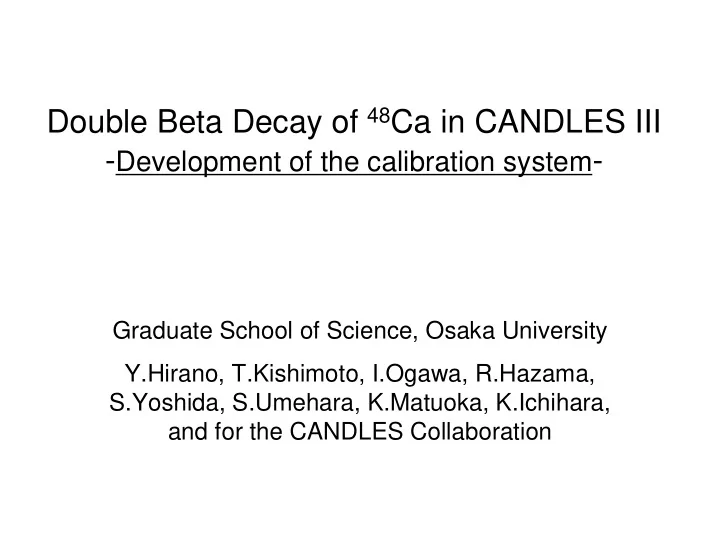

Double Beta Decay of 48 Ca in CANDLES III - Development of the calibration system - Graduate School of Science, Osaka University Y.Hirano, T.Kishimoto, I.Ogawa, R.Hazama, S.Yoshida, S.Umehara, K.Matuoka, K.Ichihara, and for the CANDLES Collaboration
Double Beta Decay ■ Neutrino-less Double Beta Decay (0 νββ ) 0 νββ rate ・ ・ ・ gives the absolute ν mass scale 0 νββ event ・ ・ ・ evidence for the Majorana nature e Beyond the Standard Model ν → ν e 0 νββ : Neutrino-less Double Beta decay ■ We are aiming for detection of 0 νββ with CANDLES
CANDLES System CAlcium fluoride for studies of Neutrino and Dark matters by Low Energy Spectrometer Double beta decay nucleus : 48 Ca ■ CaF 2 (pure) scintillator → source = detector ■ High Q-value (4.27MeV) → Low background ■ CaF 2 (pure) immersed in Liquid Scintillator → Liq. Scinti. act as 4 pi active veto
Energy Calibration in CANDLES ■ Calibration is important task to identify 0 νββ event ■ Preferable to calibrate around Q-value (4.27MeV) region - Identify Q-value region with precision ( CaF 2 (pure) Linearity has confirmed ever with accelerator and LED ) ■ Stable measurement in long period due to the rare event - Regular energy calibration - Fluctuation PMTs gain and electronics ・ ・ ・ ■ Realization of Low background environment ( Not install apparatus for calibration as much as possible)
Calibration system in CANDLES III (1) ■ No standard γ ray sources with energy around Q-value region → Sum energy of 24 Na 1.36MeV + 2.75MeV = 4.11MeV, close to the Q-value (4.27MeV) ■ Difficult to obtain photo-peak due to the low efficiency → Cut by liquid scintillator act as active veto Decay scheme of 24 Na
Calibration system in CANDLES III (2) ■ Enhance detection efficiency of sum energy peak → Underwater robot conveys the source close to CaF 2 s ( Possible to take it out of the Tank ) Underwater robot Liq.Scinti. Source CaF 2 s No source and robot at measurement time Conceptual diagram of Calibration system
Pulse Shape Discrimination in CANDLES Pulse shape of Liq. Scinti. Partial charge Time constant 10 nsec Ratio = Full charge Pulse shape of CaF 2 (pure) Time constant 900 nsec ~ 10 nsec Partial charge ~ 4000 nsec Full charge ■ Possible to discriminate these pulses Pulse shape of CaF 2 (pure) + Liq. Scinti. by using of the Ratio ■ Comparison of Ratios Liq. Scinti. > Liq. Scinti.+CaF 2 (pure) > CaF 2 (pure) ■ To Obtain CaF 2 (pure) spectrum cutting by Liquid Scintillator (active veto)
Simulation of Pulse Shape (FADC output) Pulse Shape of CaF 2 (pure)+Liq.Scinti. CaF 2 (pure) pulse shape Ratio > 0.041 Ratio ~ 0.041 Liq.Scinti. CaF 2 (pure) Collect ratios of CaF 2 (pure) Mean : 0.041 ■ It is difficult to obtain Photo peak σ : 0.0036 Cut region due to the low efficiency σ ■ If the ratio is higher than 0.041+1(or2) σ , the event is cut Distribution of Ratio of CaF 2 (pure)
PSD Simulation in CANDLES III ■ CANDLES III ・ Resolution : 4% @4.27MeV ・ Liq. Scinti. Veto Phase ( ~ 50cm) Without Cut 2 σ Cut (Liq.Scinti. Th. = 25keV) Chi square ・ ・ ・ With Cut 1.65 ・ ・ ・ Mean 4.09MeV FWHM ・ ・ ・ 4.3% 1.36MeV 4.11MeV 2.75MeV 1 σ Cut (Liq.Scinti. Th. = 50keV) Chi square ・ ・ ・ 1.83 ・ ・ ・ Mean 4.11MeV FWHM ・ ・ ・ 4.1% Correspond to Sum energy Spectra of CaF 2 (pure) ■ Possible to calibrate around Q-Value with 24 Na !
Experiment : Prototype CANDLES ■ To confirm the simulation reproduce experiment ■ CANDLES - I - 10 cm Cube : CaF 2 (pure) - Liq. Scinti. Veto Phase ~ 4 cm - 5 inch PMT × 4 ■ Activate NaCl CANDLES-I (Top view) ■ Put NaCl on CaF 2 (pure) ~ 1.6kBq ■ Measurement about 10 hours CaF 2 (pure) 10cmCube Activated NaCl 5” PMTs × 4 Liq. Scinti. CaF 2 (pure )
Result of Experiment Spectra of CaF 2 (pure) Experiment with Liq. Scinti. Cut Monte Carlo Simulation with Liq. Scinti. Cut ■ Sum peak has not seen, because ・ ・ ・ -Thin of Liq. Scinti. Veto phase -Resolution was not so good 12%@662keV -Insufficient statistics ■ The Simulation reproduce the Experiment
Summary ■ We are looking for Neutrino-less double beta decay ■ The detection system is CANDLES ■ To calibrate around Q-value, we use sum energy of 24 Na ■ Possible to calibrate around Q-value in CANDLES III ■ Sum peak has not seen with prototype CANDLES ■ The Simulation reproduce the experiment
Recommend
More recommend